- TrendsEngineering
- December 2021
Most Suitable Software Development Methodology for 2023
You already realize what you want to achieve with your software product if you are here. You might be struggling to get to that point. If having a vision of what you want to accomplish with your software product is "point A," then reaching a conclusion and developing the software is "point B." But how to get there? This is where software development methodology comes into the picture.
We want to stress a significant fact: choosing a methodology heavily depends on a project's requirement. You might need to launch a project at regular intervals and in chunks, or you might be developing something for the next three years before it hits the market.
A suitable software development methodology helps you successfully develop, deploy, and manage your software. Not just that, you can create software that perfectly aligns with your organizational strategy, goals, and the teams' overall working dynamics. Before we begin this journey of helping you develop a software development roadmap, let's delve a bit deeper into the subject matter.
What are software development methodologies?
A software development methodology refers to the structured process involved in developing a project. It combines various design philosophies and pragmatic realism to provide a systematic software development approach.
With time, many such methodologies were introduced to work efficiently with technologies, resources, and tools. A software development methodology is the most crucial fundamental functionality in determining the flow of information amongst the team members. For many modern businesses in the IT industry, implementing the proper software development methodology has become critical for improving efficiency within the organization.
The primary topic of discussion still is the selection of the correct methodology. Each methodology has its pros and cons, but it falls upon the business leaders to match them against their project requirements.
In the world of technology, there is constant disruption, and with that, the trends are also evolving. But the recent Covid-19 pandemic is propelling digital disruption. Although certain software development practices might go out of trend, they still come in handy depending on the project requirements.
Business leaders need to stay well-informed about the industry trends and create their software development strategy accordingly. Low-code development platforms are getting much recognition of late. Its market is valued at $12500 million in 2020, with the expectation to grow at a CAGR of 31.3% during the 2020-2030 timeline.
Now, let's delve into various popular software development methodologies prevalent in the market.
1. Agile
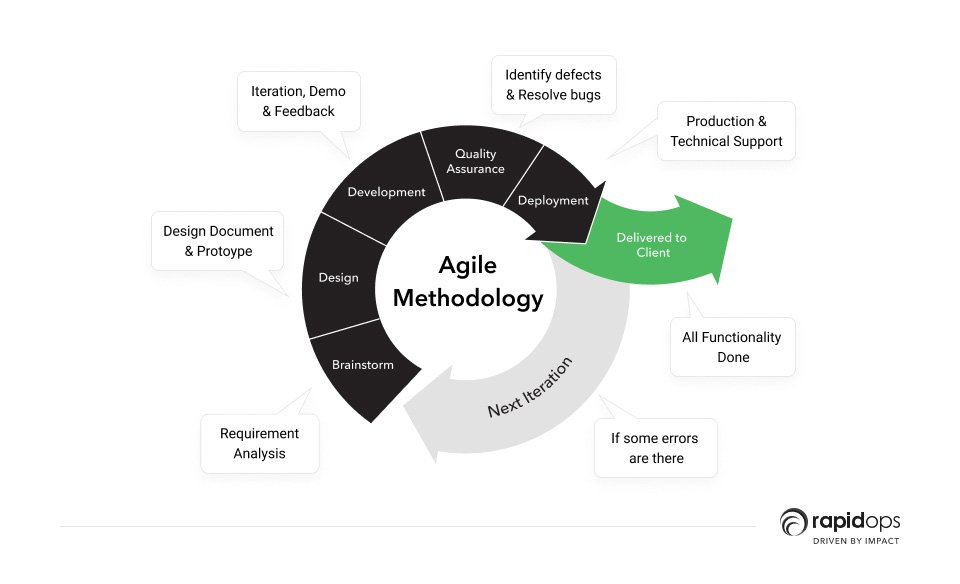
Agile methodology was developed to counter highly structured, inflexible, and complicated methods such as Waterfall. With Agile, developers can accommodate changes at will during their two-week sprint and build software at a much faster pace.
Agile methodology
- prioritizes individuals and their interactions over tools
- features customer collaboration throughout the development process
- responds to change instead of following a rigid plan
- focuses on presenting a working software over documentation
Under this approach, the development teams develop software in short sprints. Each of them has a defined duration and deliverables list. However, there is no particular order for the deliverables. During these sprints, the development team works toward delivering a tested and completely working software.
Advantages of Agile
- A collaboration-heavy methodology that focuses on team strengths, efficiency, and internal feedback
- Client satisfaction gets the highest priority
- Teams continuously deliver working, tested, prioritized features
2. Lean
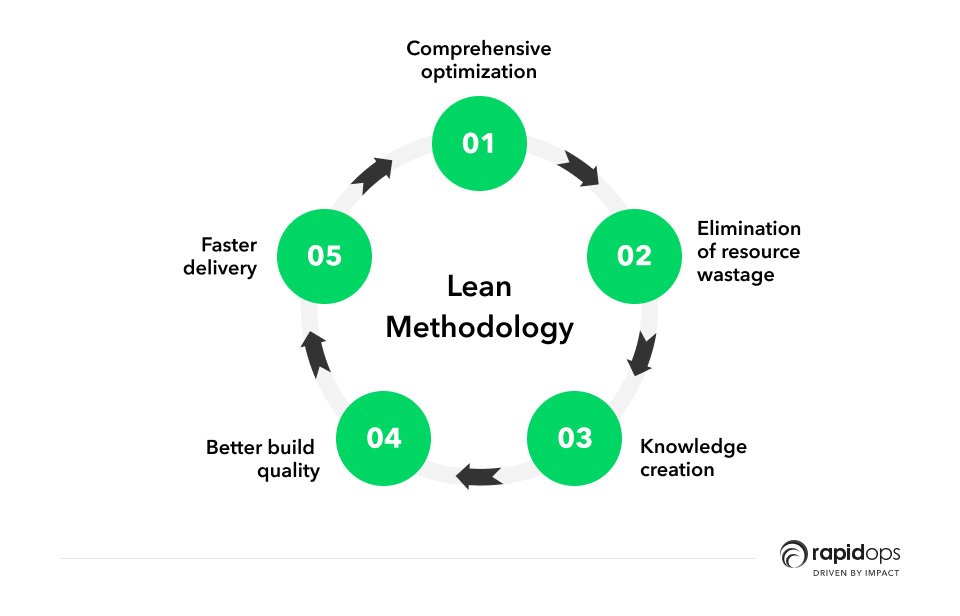
The lean methodology was created after incorporating the principles and practices from the manufacturing industry. While we support Agile as an excellent methodology for applying software development practices, it does not provide instructions for scaling them across the organization.
Lean helps enterprises to incorporate philosophies, practices, and tools to innovate at a faster level. Some of the basic principles of Lean methodology are:
Comprehensive identification and optimization of value
- Elimination of resource wastage by mapping the value stream
- Creating the value flow for better build quality
- A better time to market
- Faster product delivery
These principles help make better decisions across the organization to uncover potential issues. Organizations can implement the best of Lean with Agile methodology to create a healthy, sustainable culture of innovation and scale much faster in specific scenarios.
3. Waterfall
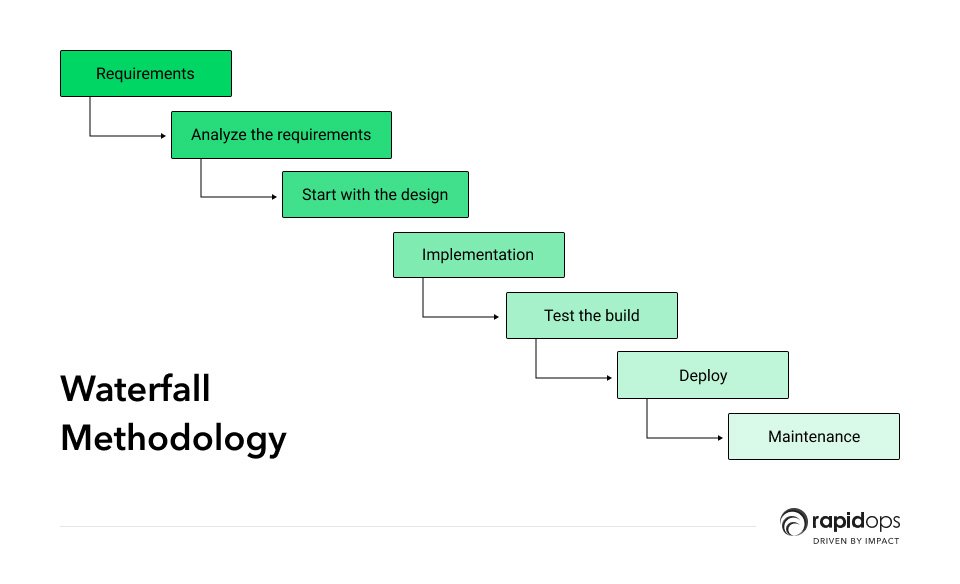
The waterfall is a traditional and sequential methodology for software development. This methodology is often considered an "old school" or outdated method; however, it has not lost its prominence due to its plan-driven approach.
Before starting the software development project, waterfall requires well-defined and structured software documentation. The methodology is divided into autonomous stages. The first stage is essential as it requires a complete understanding and agreement between developers and customers regarding the project's demands and scope.
The stages are rigid and must follow a set-in-stone sequence
- Determine project requirements and their overall scope
- Analyze the requirements
- Start with the design
- Implement the frameworks and tools
- Test the build
- Deploy it to the sandbox
- Create feedback and start the maintenance
It seems like any basic methodology, right? But we must remind you that there is a lack of flexibility with this approach. The parameters and flow decided by the customer and developer before development must be followed till the end. If mistakes need redressal, the project will require a complete restart, even toward the end stages.
The general thumb rule here is that one stage must be finished before the next begins. This helps organizations carry out the tasks in a much smoother manner. As the full scope of the software development project gets discussed and agreed upon in advance, software progress becomes easily measurable.
This software development methodology often comes in handy for long-term plan-driven teams. So, if your software project doesn't operate in a vacuum, you are likely to get better results with much more flexible modern methodologies.
4. Extreme programming development
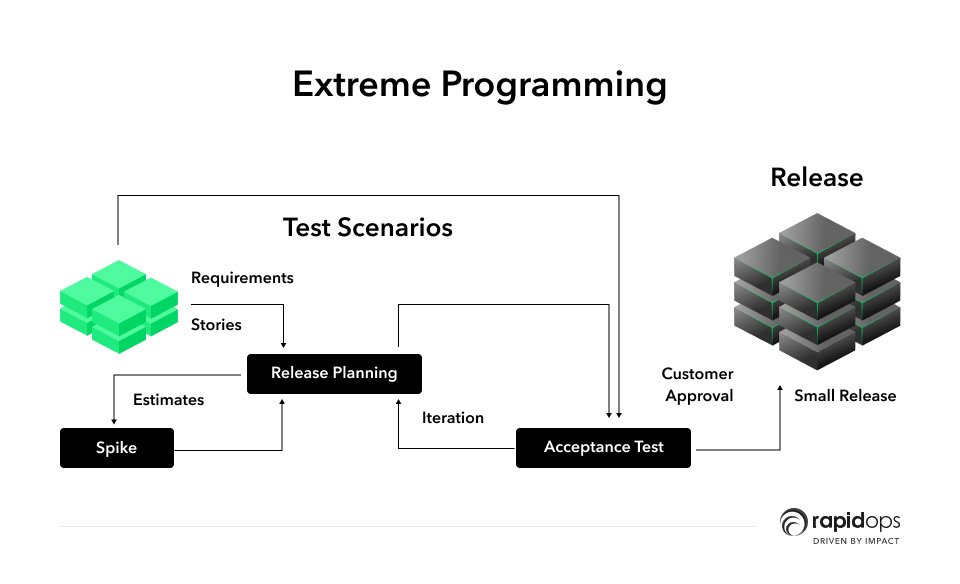
Extreme Programming (or XP) is an Agile framework used while developing higher quality software using the best practices in software development. This approach enables the concerned teams to frequently release short development sprints, which can be easily altered as per the required changes.
In Extreme Programming, developers generally follow a set of values instead of steps, which are:
1. Communication
Software development success is heavily dependent on good team communication. Communication of knowledge, issues, and resolution is crucial, and Extreme Programming stresses this importance with face-to-face discussions.
3. Simplicity
Here, simplicity implies building the most functional feature. "What is the most straightforward tweak that will work?” Avoid waste and carry out essential work like keeping the system design simple. A simple system design is easier to maintain, support, and revise.
3. Feedback
Development teams can identify areas of improvement and revise their practices promptly with the help of continuous feedback. So, the development team designs something, gathers feedback on design and implementation, and then makes the necessary adjustments.
4. Courage
"Effective action in the face of fear." Courage is necessary to raise organizational issues that affect a team's efficiency.
It takes courage to stop the practices that are not bringing in any result. It takes courage to accept and act on feedback to achieve the end goal of developing the right software.
5. Respect
All the team members need to know and respect each other's skills, talents, and shortcomings. The value of respect allows all the other values to function correctly so that the end goal is achieved without any roadblocks. Respect is essential if you want the software to be the best in class and design.
5. Feature-driven development
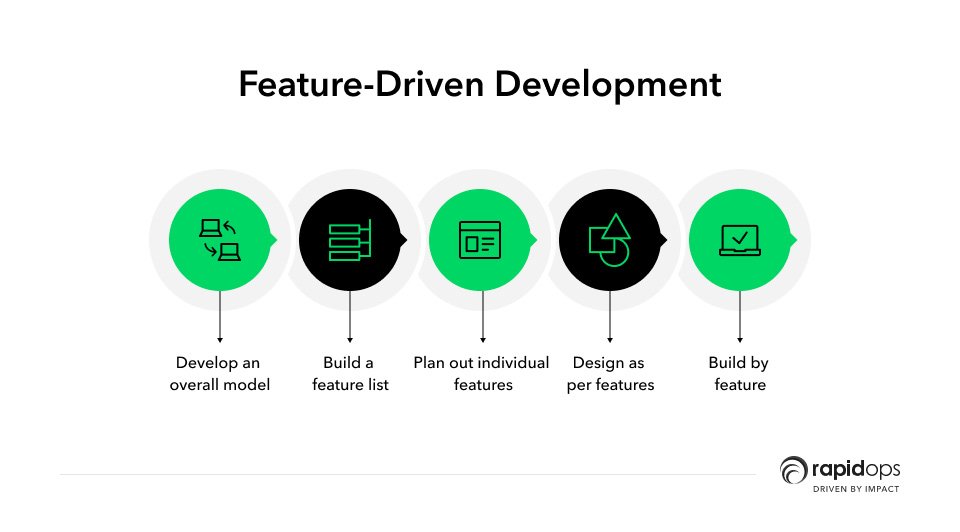
Feature-Driven Development (FDD) is an iterative and incremental approach to software development derived from the Agile methodology. It is a client-centric approach and is a good fit for smaller development teams.
As the name suggests, features are the foundation of FDD, and they are client-valued requirements that must be fulfilled every two weeks. FDD has five steps for developing tangible software quickly and efficiently.
Here are the steps involved in the software development model under FDD.
- Develop an overall model
- Build a feature list
- Plan out individual features
- Design as per features
- Build by feature
The last step in this approach generally takes up most of the development teams' effort. Under FDD, status reporting is encouraged at each stage and allows the team to track progress, results, and possible errors.
Efficient response to change is an essential attribute of FDD. However, it is also crucial to thoroughly understand the client's requirements and plan out the overall model at the beginning of the project to avoid any surprising errors.
If any feature takes longer than two weeks, it must be broken down into separate features until it meets the two-week rule. This rigid FDD structure of software development makes it a lesser choice for development teams with a project-driven and break-fix process.
Software development lifecycle (SDLC)
The software development methodology is part of the software development life cycle. As the name suggests, SDLC is followed for carrying out a software project. It involves creating a detailed plan of developing, maintaining, altering, or enhancing specific software. Improving the quality of user experience and the development process is defined by SDLC.
There are seven primary stages in the software development process. Let's take a glance at these general stages towards the SDLC approach.
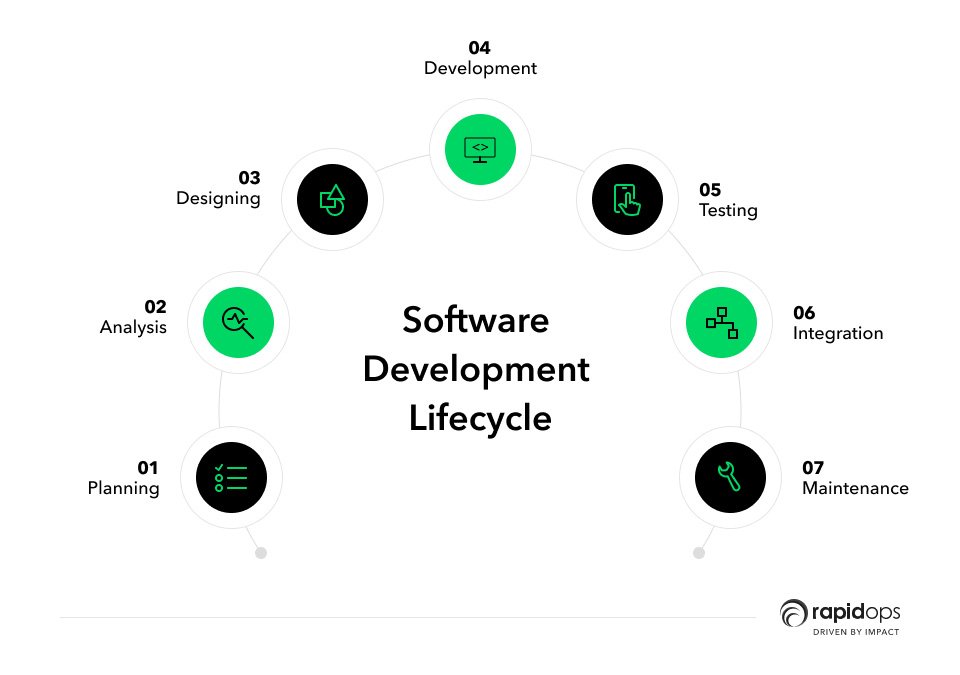
Stage 1: Planning
Developers plan the upcoming project by defining their new systems' problem, scope, and objectives in the planning stage.
Stage 2: Analysis
In this stage, developers gather specific details and determine the initial ideas for prototypes.
Stage 3: Designing
In the designing stage, developers create an outline with the details of the whole application and its various aspects.
Stage 4: Development
Developers write the code and build the application as per their earlier design documents and outline in the development stage.
Stage 5: Testing
Once the software is developed, it is tested to match the end-user experience and handle the necessary fixes.
Stage 6: Integration
Here the overall software design comes together with the help of different modules getting integrated into the primary source code.
Stage 7: Maintenance
Once the software reaches the market, developers get into the maintenance mode and begin practicing relevant activities for resolving issues reported by end-users.
The Rapidops digital product development process
We hope that the above content was able to help you understand that your projects and its needs must be considered when selecting the software development methodology. Keeping that in mind, we can safely suggest that no single methodology can come in handy for you.
This section will showcase the general approach we take, not a particular software development methodology, to help build a great digital experience for our clients.
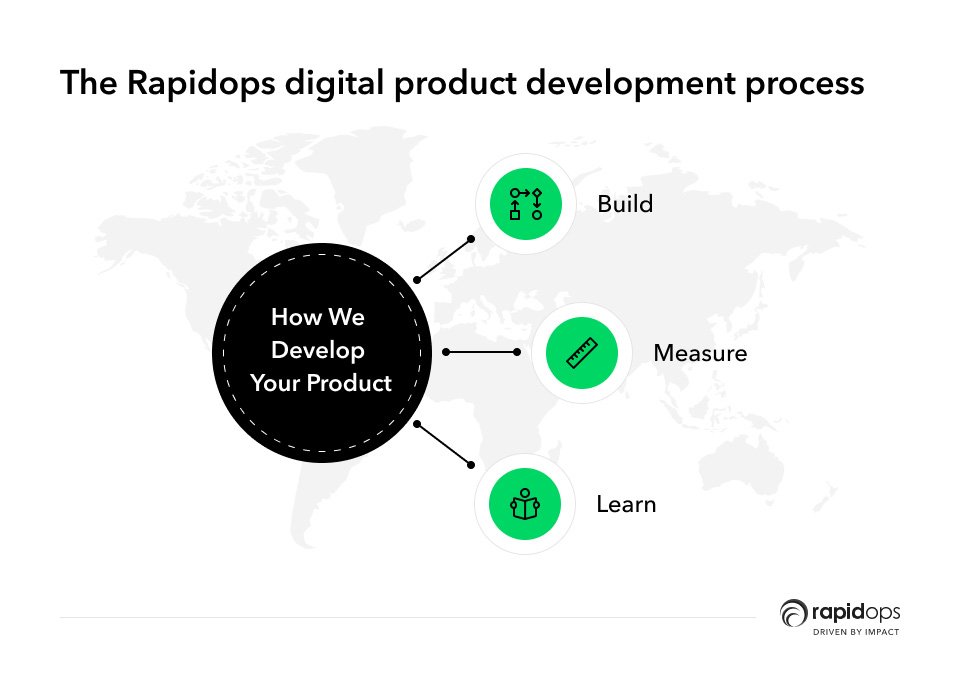
Description automatically generated At Rapidops, the concept adopted for developing your next ground-breaking digital product revolves around three factors
1. Build
We understand the client's plan with a more holistic approach. We discuss the nitty-gritty, including the project requirement, delivery expectations, tools, and the various frameworks.
2. Measure
We analyze our development team's work, irrespective of the methodology chosen for developing the software. We match it against the agreements, and the framework decided before undertaking the development process.
3. Learn
Once the work analysis is matched against the client's requirements with the help of tangible software, we derive the learnings. Learning is both positive and negative. If there were undetected bugs, why were they not dealt with at the early measurement stage? What went into that winning combination if we delivered the product before the deadline?
These three principles are the guiding light that helps us adjust to the industries we currently serve. Every client is unique and vital, so we give our best to have a workable and scalable framework in place that is best suited for their dynamic demand.
Conclusion: Choose the correct software development methodology to reach your organizational end goal
Software development methodologies can be considered a guided approach to developing software and apps. They have been present since the early days of programming, and there is a good reason they are still used in this modern age.
As we witnessed above, there are many old and new software development methodologies, and in time, there will be unique ones as well. But we cannot rank them or rate that this is the best one out there.
Deciding between these software development methodologies will always involve
- team structure
- team experience
- project requirements
- project goals
- project budget
We hope this article guided you in understanding the most suitable methodology fit according to your project requirement! If you want to know more about these methodologies or how you can get them to work for you, feel free to get in touch with us.




